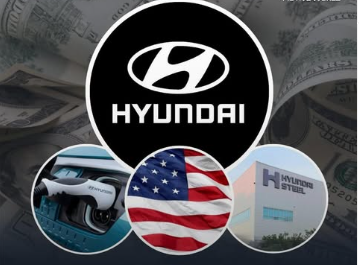Global economic leadership in the years to come will be determined by the interplay between creativity and capital. It appears that Hyundai Motor Group is remarkably cognizant of this. Not just a business expansion, its recently announced $21 billion investment in the US is a visionary plan to integrate innovation, sustainability, and job creation into the very fabric of American industry.
Hyundai is opening more than just plants by investing in clean energy, robotics, artificial intelligence, low-carbon steel, and vehicle production. Routes to more robust supply chains, cleaner power, and smarter factories. Hyundai is bringing seemingly unrelated components together into a cohesive industrial strategy, which is strikingly similar to how a conductor arranges a symphony.
Hyundai’s U.S. Investment Plan – Key Highlights
| Attribute | Details |
|---|---|
| Total U.S. Investment | $21 Billion |
| Primary Locations | Georgia (EV Metaplant), Louisiana (Low-Carbon Steel Mill) |
| Annual Vehicle Production Goal | 1.2 Million Units by 2028 |
| Direct Jobs Expected | 14,000 (100,000+ including indirect impact) |
| Flagship Partners | Boston Dynamics, NVIDIA, Aptiv, Holtec International |
| Focus Sectors | EVs, Robotics, AI, Autonomous Driving, Steel, Sustainable Energy |
| Authentic Source | Hyundai Motor Group Official Website , Instagram |
Steel, AI, and the Revolution of the Smart Factory
Hyundai is setting the standard for a manufacturing model that is incredibly flexible and efficient by incorporating robotics and artificial intelligence into its U.S. production facilities. Collaborations with Boston Dynamics and NVIDIA are part of the company’s $6 billion tech-focused division, which is driving advancements in automation, predictive maintenance, and machine learning.
At a time when global manufacturing is struggling with labor shortages and uncertain logistics, this investment feels especially innovative. Hyundai’s approach is not only technologically sophisticated, but it also strikes a remarkable balance between productivity and long-term human capital development by optimizing operations and freeing up human talent for higher-order tasks.
Georgia’s Metaplant: A Flagship That Is More Than a Factory
One of the best examples of what manufacturing can look like in the future is Hyundai’s $7.6 billion Metaplant in Georgia. This facility, which is expected to deliver electric vehicles on a large scale, will also act as a test site for modular expansion, smart systems, and sustainable energy use. Executives compared the plant to “a living ecosystem” during the opening ceremony, saying it can learn, adapt, and scale as the regulatory and consumer landscapes change.
The story of American manufacturing over the last ten years has frequently been one of decline. However, initiatives like this are changing that. The plant provides economic revitalization to communities throughout Georgia, serves as a canvas for engineers, and serves as a proof-of-concept for policymakers regarding the potential of contemporary industrial policy.
More Supporting Steel Than Automobiles
At the same time, Hyundai has demonstrated a pragmatic and symbolic commitment to sustainability by investing $5.8 billion in a new electric arc furnace (EAF) steel facility in Louisiana. The facility will greatly lessen reliance on imported steel while meeting Hyundai’s increasing demand in the United States by producing 2.7 million metric tons of low-carbon steel annually.
This plant’s purpose is very clear when considering supply chain vulnerability and climate change. It lays the groundwork for a cleaner materials economy while lowering emissions, increasing self-reliance, and directly creating more than 1,400 jobs.
Constructing the Future Mobility Web
Hyundai’s push into advanced air mobility (AAM) and electric vertical take-off and landing (eVTOL) aircraft through its U.S.-based affiliate, Supernal, is arguably the most futuristic aspect of its investment strategy. Hyundai plans to have an operational network of urban air vehicles by 2028 that will cut emissions, avoid traffic, and transform city life.
Hyundai is positioned at the intersection of artificial intelligence and mobility thanks to its collaboration with Aptiv to jointly develop autonomous driving platforms and its provision of robotaxis to Waymo. These initiatives offer new means of moving people and goods in increasingly congested cities, which is especially advantageous for consumer choice as well as technological leadership.
Putting Money Into Infrastructure and Energy, Not Just Cars
Hyundai is increasing its investment footprint in clean nuclear energy by working with Holtec International on Small Modular Reactors (SMRs), something that few automakers have ventured to do. Furthermore, the company’s involvement in the IONNA EV charging alliance is part of a larger plan to guarantee that the growth of EVs is backed by easily accessible and effective charging infrastructure.
Reliability in energy has emerged as a key component of national security and the economy in recent years. Therefore, Hyundai’s strategic energy investments are not incidental; rather, they are essential to the transportation industry’s future.
Beyond Machines: Putting Money Into People and Advancement
Hyundai anticipates creating more than 14,000 full-time jobs with this $21 billion commitment by 2028, with indirect job creation expected to reach 100,000. These figures are more than just figures; they reflect thriving communities, revitalized towns, and the chance for thousands of people to help create the industries of the future.
Hyundai’s program, which offers both training and technology transfer, is a prime example of economic optimism in the field of workforce development. It serves as a reminder that human ROI is just as important as ROI when it comes to smart capital deployment.


